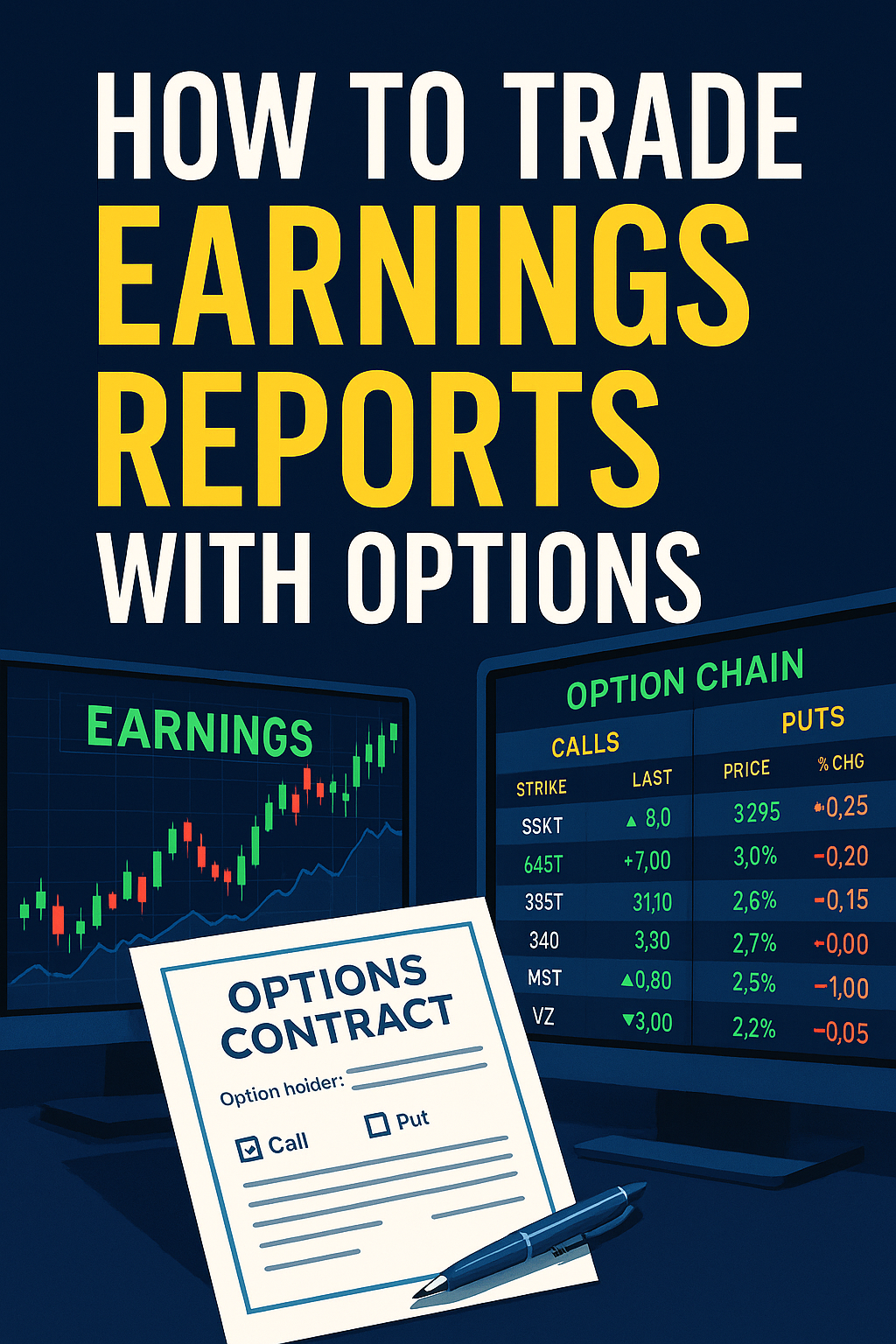Trading earnings with options is like playing Russian roulette with five bullets in the chamber while blindfolded. I know because I’ve pulled the trigger about 200 times, and while I’m still alive, my account has died multiple deaths. I’ve made $15,000 on a single Netflix earnings play and lost $12,000 on Apple earnings the same week. It’s the most degenerate form of options trading that exists, and I’m about to teach you exactly how to do it.
Let me be brutally clear: earnings trades are not investing. They’re not even really trading. They’re educated gambling where the house (market makers) has a massive edge, and you’re trying to exploit the few moments where probability temporarily shifts in your favor. After losing $45,000 on earnings plays in my first two years, I finally figured out strategies that work. Not every time – nothing works every time with earnings – but enough to turn this casino game profitable.
Here’s what makes earnings so seductive and so deadly: a stock can move 10-20% overnight, turning a $500 option into $5,000 or $0. There’s no in-between. It’s binary. Win big or lose everything. And the worst part? Being right about the direction isn’t enough. You need to be right about direction, magnitude, and timing, all while fighting IV crush that can destroy you even when you nail the move.
The Earnings Options Math Nobody Explains
The Expected Move Calculation
Market makers price in expected moves. This is crucial and most traders don’t understand it.
Expected Move = (ATM Call + ATM Put) × 0.85

Example: Apple Earnings
- Stock at $180
- ATM call: $4.00
- ATM put: $3.80
- Total: $7.80
- Expected move: $6.63 (3.7%)
This means AAPL needs to move more than 3.7% for buyers to profit. It moves exactly 3.7% on average. The house always wins.
The IV Crush Reality
Before Earnings:
- Implied Volatility: 80%
- Call option price: $5.00
After Earnings (stock up 5%):
- Implied Volatility: 30%
- Call option price: $3.00
You were right about direction, stock moved 5%, you still lost 40%. This is IV crush, and it’s murdered more accounts than anything else.
My Netflix IV Crush Disaster:
- Bought calls for $12 before earnings
- Netflix beat, raised guidance, stock up 4%
- Calls worth $7 after earnings
- Lost $5 per contract being RIGHT
The Strategies That Actually Work (Sometimes)
Strategy 1: The Pre-Earnings IV Ramp
Buy options 2-3 weeks before earnings, sell the day before.
How It Works:
- IV increases as earnings approach
- Options gain value even if stock flat
- Sell before the actual event
- Never hold through announcement
My Recent Trade:
- NVDA earnings in 10 days
- Bought $650 calls for $15
- IV went from 45% to 75%
- Sold day before earnings for $24
- Profit: $900 (60%)
- Never risked the actual earnings
Success Rate: 65%
Average Gain: 20-40%
Risk: Stock moves against you before earnings
Strategy 2: The Straddle Strangle (For Big Movers)
Buy both calls and puts on stocks that historically move big.
Criteria:
- Stock must average 8%+ moves on earnings
- IV not already insane (under 100%)
- Buy ATM straddle or OTM strangle
My ROKU Straddle:
- ROKU at $65 before earnings
- Historical moves: 15%, 12%, 18%, 9%
- Bought $65 straddle for $8
- Earnings: Stock dropped to $56 (14% move)
- Put worth $9, call worth $0.50
- Total: $9.50
- Profit: $150 (19%)
Success Rate: 45%
Average Gain When Wins: 50-100%
Average Loss: -60%
Strategy 3: The Iron Condor (Betting on No Movement)
Sell OTM call and put spreads. Profit if stock stays within range.
Best For:
- Large caps with low historical moves
- When IV is extremely elevated
- Stocks pinned by market makers
My MSFT Iron Condor:
- MSFT at $380 before earnings
- Expected move: $15
- Sold $365/$360 put spread and $395/$400 call spread
- Collected $200 total premium
- MSFT moved to $385 (within range)
- Kept entire $200
Success Rate: 70%
Average Gain: 15-25%
Risk: Stock moves beyond expected
Strategy 4: The Backspread (High Risk, High Reward)
Sell 1 ATM option, buy 2 OTM options.
Example Setup:
- TSLA at $800
- Sell 1 $800 call for $30
- Buy 2 $820 calls for $15 each
- Net: Even money
- If TSLA explodes above $840, massive profit
- If stays near $800, small loss
My TSLA Backspread Win:
- Set up for free (net zero cost)
- TSLA announced surprise profit
- Stock went to $880
- Made $4,000 on a free trade
Success Rate: 25%
When It Wins: 500-1000% returns
When It Loses: -100% (if did for debit)
Strategy 5: The Calendar Spread (IV Crush Play)
Buy long-dated option, sell short-dated same strike.
Setup:
- Buy option 60 days out
- Sell option expiring right after earnings
- Profit from IV crush on short option
My AAPL Calendar:
- Bought 60-day $180 call for $8
- Sold earnings week $180 call for $5
- Net debit: $3
- After earnings, short call expired worthless
- Long call still worth $6
- Profit: $300 (100%)
Success Rate: 60%
Risk: Stock moves too much either direction
The Earnings Plays to NEVER Make
Never Buy Deep OTM Options
“AMZN only needs to move 10% for these to 10x!”
Reality: Bought $0.50 calls, stock moved 7%, calls expired worthless. Lost everything.
Never Hold Through Multiple Earnings
“I’ll hold these LEAPS through 4 earnings!”
Reality: IV crush four times. Even if stock goes up, options lose value each earnings.
Never Buy Same-Day Expiration
“0DTE earnings play for maximum leverage!”
Reality: No time for recovery if wrong. Binary outcome. Lost $5,000 in 5 minutes on GOOGL.
Never Use Your Whole Account
“This is a sure thing based on whisper numbers!”
Reality: Lost 80% of account on one NFLX trade. Took 18 months to recover.
Never Trust Unusual Options Activity
“Someone bought 10,000 calls, they must know something!”
Reality: Could be hedge, could be spread, could be dumb money. Lost $3,000 following “smart money” into SNAP.
My Earnings Trading Track Record (The Good, Bad, and Ugly)
The Wins
ROKU Q3 2023:
- Bought straddle for $12
- Stock moved 18%
- Made $2,100 (175% return)
NVDA Q2 2023:
- Sold iron condor for $300
- Stock stayed in range
- Kept premium
NFLX Q1 2023:
- Pre-earnings IV play
- Bought calls 2 weeks early
- Sold day before for 40% gain
The Losses
META Q4 2022:
- Bought calls for $8
- Stock dropped 20%
- Total loss: $800
AMZN Q3 2023:
- Bought puts expecting miss
- They beat huge
- Lost $1,500
DIS Disaster:
- Strangle for $15
- Stock moved 2%
- Lost $1,400 (93%)
Overall Statistics (200+ Trades)
- Win Rate: 38%
- Average Win: +120%
- Average Loss: -65%
- Net Profitable: Yes (barely)
- Stress Level: 11/10
- Would Recommend: No
The Pre-Earnings Checklist
Before any earnings trade, I go through this:
1. Historical Movement Analysis
Check last 8 earnings:
- Average move: Must be >6%
- Biggest move: Note outliers
- Direction bias: Any patterns?
- Misses vs beats: Reaction consistency?
2. IV Analysis
Current IV vs historical:
- IV Rank: Where is it percentile-wise?
- IV vs HV: Is IV inflated?
- Expected move: Can stock exceed it?
3. Options Pricing
- Straddle cost vs expected move
- Skew: Are puts or calls overpriced?
- Volume: Enough liquidity?
- Spread: Not too wide?
4. Technical Setup
- Support/resistance levels
- Recent trend
- Gap fill potential
- Volume patterns
5. Fundamental View
- Analyst expectations
- Whisper numbers
- Sector performance
- Macro environment
If any red flags, skip the trade.
The Earnings Calendar Approach
Monday/Tuesday Earnings
- Less competition for edge
- Often bigger moves
- Better risk/reward
- Examples: NFLX, IBM, TSLA
Wednesday (Avoid)
- Fed days often
- Macro can overshadow
- Unpredictable
Thursday (The Big Day)
- Most companies report
- Can find opportunities
- But also most efficient pricing
Friday (Wildcards)
- Fewer reports
- Can get weird moves
- Lower liquidity
Position Sizing for Earnings
My Rules:
- Maximum 2% of account per trade
- Never more than 3 earnings plays per week
- Scale based on conviction:
- High conviction: 2%
- Medium: 1%
- Low: 0.5%
Example with $50,000 Account:
- Max per trade: $1,000
- Weekly max: $3,000
- Monthly max: $12,000 (24%)
This prevents one bad earnings season from destroying you.
Managing Earnings Trades
Before the Announcement
T-5 Days:
- Enter IV ramp plays
- Set up hedges
- Final research
T-1 Day:
- Close IV plays
- Final entries for event
- Double-check everything
Day Of:
- No new positions after 2 PM
- Set alerts
- Prepare for after-hours
After the Announcement
Immediate:
- Check the move
- Calculate P&L
- Don’t panic
Next Morning:
- Usually best exit time
- IV crushed but stable
- Volume returns
Never:
- Hold hoping for continuation
- Average down
- Revenge trade the same stock
The Best Stocks for Earnings Plays
High Movers (Straddles)
- ROKU: Average 12% move
- SNAP: Average 15% move
- PINS: Average 10% move
- SQ: Average 9% move
- DKNG: Average 11% move
Low Movers (Iron Condors)
- JNJ: Average 2% move
- WMT: Average 3% move
- PG: Average 2.5% move
- KO: Average 2% move
- VZ: Average 3% move
IV Ramp Plays
- NVDA: IV always explodes
- TSLA: Huge IV expansion
- NFLX: Reliable IV increase
- AMD: Good IV patterns
My Current Earnings Strategy
After years of trial and expensive error:
Allocation
- 70%: Pre-earnings IV plays (close before)
- 20%: Iron condors on low movers
- 10%: Straddles on reliable movers
- 0%: Directional bets (never again)
Monthly Results
- Average trades: 15
- Win rate: 55%
- Average return: 8%
- Time spent: 20 hours
- Stress: Manageable
Best Quarter Ever
Q1 2023: +$12,000
- NFLX straddle: +$3,000
- TSLA IV play: +$2,000
- MSFT condor: +$500
- Multiple small wins
Worst Quarter Ever
Q4 2021: -$8,000
- PTON calls: -$3,000
- ZM puts: -$2,000
- PYPL straddle: -$1,500
- Everything went wrong
The Bottom Line on Earnings Trading
Earnings trading with options is the closest thing to pure gambling in the stock market. After 200+ trades and countless sleepless nights watching after-hours action, here’s my verdict:
The Good:
- Can make massive returns quickly
- Defined event with known timeline
- Predictable IV patterns
- Exciting (if you like stress)
The Bad:
- Most trades lose money
- IV crush is brutal
- Being right isn’t enough
- Extremely stressful
The Reality:
If you must trade earnings, treat it like a casino:
- Only bring money you can lose
- Have a system and stick to it
- Never chase losses
- Know when to walk away
The smartest earnings trade? Selling premium to the gamblers. But if you insist on buying, at least now you know how to not lose everything immediately.
Remember: The market makers pricing these options have PhDs, supercomputers, and decades of data. You have Robinhood and a dream. The odds are not in your favor. Trade accordingly.







